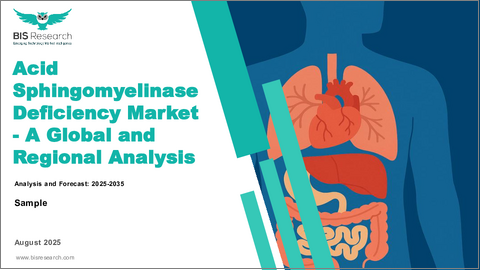|
|
市場調査レポート
商品コード
1789845
酸性スフィンゴミエリナーゼ欠損症市場- 世界および地域別 - 分析と予測(2025年~2035年)Acid Sphingomyelinase Deficiency Market - A Global and Regional Analysis: Analysis and Forecast, 2025-2035 |
||||||
カスタマイズ可能
|
|||||||
| 酸性スフィンゴミエリナーゼ欠損症市場- 世界および地域別 - 分析と予測(2025年~2035年) |
|
出版日: 2025年08月14日
発行: BIS Research
ページ情報: 英文 100 Pages
納期: 1~5営業日
|
全表示
- 概要
- 図表
- 目次
酸性スフィンゴミエリナーゼ欠損症(ASMD)は、SMPD1遺伝子の変異によって引き起こされるまれな遺伝性疾患で、酸性スフィンゴミエリナーゼ酵素の欠損または欠失をもたらします。
この酵素は、細胞膜に存在する脂質であるスフィンゴミエリンの分解に必須です。酵素活性が十分でないと、スフィンゴミエリンは細胞、特に肝臓、脾臓、肺、場合によっては中枢神経系に蓄積し、進行性の細胞機能障害を引き起こします。酸スフィンゴミエリナーゼ欠損症は3つのタイプに分類されます。A型は重度の神経臓器症状を呈し、ほとんどの小児が幼児期を過ぎられない予後不良のタイプ、B型は主に肝臓や脾臓などの臓器に影響を及ぼしますが、神経学的な病変はなく、治療により長寿が期待できるタイプ、C型は臓器症状と神経症状の両方を呈し、重症度や予後は様々です。この疾患は依然として困難な疾患ですが、現在進行中の新たな治療法の調査により、酸性スフィンゴミエリナーゼ欠損症の患者の予後と生活の質を改善する希望が見えてきました。
酸性スフィンゴミエリナーゼ欠損症市場の主要促進要因のひとつは、酵素補充療法(ERT)の導入と採用です。2022年にFDAによって承認されたこの治療は、酸性スフィンゴミエリナーゼ欠損症の非中枢神経系症状に対する効果的な治療選択肢を提供することで、治療状況に大きな影響を与えています。ゼンポザイムは臨床試験において、スフィンゴミエリン蓄積の減少、臓器機能の改善、患者のQOLの向上など、有望な結果を示しています。米国、日本、EUを含む様々な世界市場での承認とその後の採用により、医療提供者が患者に提供できる実行可能な治療法を手に入れたため、診断率が上昇しました。より多くの患者が治療を求めるようになり、ヘルスケア・システムが酸性スフィンゴミエリナーゼ欠損症の治療に多くのリソースを割くようになったためです。ゼンノポザイムが利用可能になったことで、酸性スフィンゴミエリナーゼ欠損症市場は、選択肢が限られたニッチな分野から、よりダイナミックで進化する治療分野へと拡大し、変貌を遂げました。
酸性スフィンゴミエリナーゼ欠損症市場の成長にもかかわらず、その本格的な開拓と影響を妨げる可能性のある課題がいくつか残っています。重要な課題のひとつは、治療費の高さです。
酸スフィンゴミエリナーゼ欠乏症はまれで複雑な疾患であり、その症状はしばしば他の疾患と重複するため、早期診断が困難です。診断が遅れるということは、多くの患者が病気が進行するまで治療を開始しないことを意味し、特に幼児型や神経内臓型では不可逆的な臓器障害を引き起こす可能性があります。
さらに、患者数が限られているため、臨床試験のリクルートが困難です。酸性スフィンゴミエリナーゼ欠損症は非常にまれな疾患であるため、臨床試験に十分な患者を登録することが困難であり、新しい治療法や治療法の開発が遅れる可能性があります。このことは、市場予測や長期的な治療戦略も複雑にしており、企業は患者数が比較的少ない市場に多額の投資をしたがらない可能性があります。
最後に、規制上の課題もあります。特に、有効性と安全性に関するデータが限られている希少疾患の場合、新規治療の承認プロセスは長く複雑なものになる可能性があります。
結論として、酸性スフィンゴミエリナーゼ欠損症市場は成長を遂げていますが、高額な治療費や診断の遅れ、臨床試験募集の困難さ、規制上のハードルなど、これらの課題は患者にとっての治療選択肢のアクセシビリティと持続可能性に影響を与え続けています。これらの課題に対処することは、より多くの患者がタイムリーで効果的な治療法を利用できるようにするために極めて重要です。
世界の酸性スフィンゴミエリナーゼ欠損症市場は競争が激しく、複数の大手企業が積極的に参入しています。これらの企業は、酸スフィンゴミエリナーゼ欠乏症患者のアンメットニーズに対応するための継続的な研究、開発、取り組みを通じて、市場の展望を形成しています。
当レポートでは、世界の酸性スフィンゴミエリナーゼ欠損症市場について調査し、市場の概要とともに、地域別の動向、および市場に参入する企業のプロファイルなどを提供しています。
目次
エグゼクティブサマリー
第1章 市場:業界展望
- 市場動向
- 規制の枠組み
- 臨床試験
- 市場力学
- 影響分析
- 市場促進要因
- 市場の課題
- 市場機会
第2章 世界の酸性スフィンゴミエリナーゼ欠損症市場(地域別)100万米ドル、2023年~2035年
- 北米
- 欧州
- アジア太平洋
第3章 世界の酸性スフィンゴミエリナーゼ欠損症市場:競合情勢と企業プロファイル
- 主要戦略と開発
- 合併と買収
- 相乗効果のある活動
- 事業拡大と資金調達
- 製品の発売と承認
- その他の活動
- 企業プロファイル
- Sanofi
- Actelion Pharmaceuticals
第4章 調査手法
List of Figures
- Figure: Global Acid Sphingomyelinase Deficiency (ASMD) Market (by Region), $Million, 2024 and 2035
- Figure: Global Acid Sphingomyelinase Deficiency (ASMD) Market Key Trends, Analysis
List of Tables
- Table: Global Acid Sphingomyelinase Deficiency (ASMD) Market, Pricing Analysis,
- Table: Global Acid Sphingomyelinase Deficiency (ASMD) Market Dynamics, Impact Analysis
- Table: Global Acid Sphingomyelinase Deficiency (ASMD) Market (by Region), $Million, 2024-2035
Global Acid Sphingomyelinase Deficiency Market, Analysis and Forecast: 2025-2035
Acid sphingomyelinase deficiency (ASMD) is a rare genetic disorder caused by mutations in the SMPD1 gene, which leads to a deficiency or absence of the acid sphingomyelinase enzyme. This enzyme is essential for breaking down sphingomyelin, a lipid found in cell membranes. Without sufficient enzyme activity, sphingomyelin accumulates in cells, particularly in the liver, spleen, lungs, and, in some cases, the central nervous system, leading to progressive cellular dysfunction. Acid sphingomyelinase deficiency manifests in three types: Type A, which presents with severe neurovisceral symptoms and has a poor prognosis with most children not surviving past early childhood; Type B, which primarily affects organs like the liver and spleen but lacks neurological involvement, allowing for a longer lifespan with treatment; and Type C, which includes both organ and neurological symptoms with varying degrees of severity and prognosis. Though the disorder remains challenging, ongoing research into additional therapies offers hope for improving outcomes and quality of life for individuals affected by acid sphingomyelinase deficiency.
One of the key drivers of the acid sphingomyelinase deficiency market is the introduction and adoption of enzyme replacement therapies (ERTs). This therapy, approved by the FDA in 2022, has significantly impacted the treatment landscape by providing an effective treatment option for non-central nervous system manifestations of acid sphingomyelinase deficiency. Xenpozyme has shown promising results in clinical trials, including the reduction of sphingomyelin accumulation, improved organ function, and enhanced patient quality of life. Its approval and subsequent adoption in various global markets, including the U.S., Japan, and the EU, have driven increased diagnosis rates, as healthcare providers now have a viable treatment to offer patients. This has led to market growth, as more patients are seeking treatment, and healthcare systems are dedicating more resources to managing acid sphingomyelinase deficiency. The availability of Xenpozyme has transformed the acid sphingomyelinase deficiency market, expanding it from a niche segment with limited options to a more dynamic and evolving therapeutic area.
Despite the growth of the acid sphingomyelinase deficiency market, several challenges persist that could potentially hinder its full development and impact. One significant challenge is the high cost of treatment.
Another challenge is the diagnostic delay; acid sphingomyelinase deficiency is a rare and complex disorder, and its symptoms often overlap with other conditions, making it difficult to diagnose early. Delayed diagnosis means that many patients do not begin treatment until the disease has progressed, potentially leading to irreversible organ damage, particularly in the infantile and neurovisceral forms of the disease.
Additionally, the limited patient population poses difficulties in clinical trial recruitment. Because acid sphingomyelinase deficiency is so rare, enrolling enough patients for clinical trials can be a challenge, slowing down the development of new treatments and therapies. This also complicates market forecasting and long-term treatment strategies, as companies may be reluctant to invest heavily in a market with a relatively small patient base.
Finally, regulatory hurdles also present a challenge. The approval processes for new treatments can be lengthy and complex, particularly for rare diseases, where data on efficacy and safety may be limited.
In conclusion, while the acid sphingomyelinase deficiency market is experiencing growth, these challenges, ranging from high treatment costs and diagnostic delays to clinical trial recruitment difficulties and regulatory hurdles, continue to impact the accessibility and sustainability of treatment options for patients. Addressing these challenges will be crucial for ensuring that more patients have access to timely and effective therapies.
The global acid sphingomyelinase deficiency market is highly competitive, with several major companies actively involved. These companies are shaping the market landscape through their ongoing research, development, and efforts to address the unmet needs of acid sphingomyelinase deficiency patients.
Table of Contents
Executive Summary
Scope and Definition
Market/Product Definition
Inclusion and Exclusion
Key Questions Answered
Analysis and Forecast Note
1. Markets: Industry Outlook
- 1.1 Market Trends
- 1.2 Regulatory Framework
- 1.3 Clinical Trails
- 1.4 Market Dynamics
- 1.4.1 Impact Analysis
- 1.4.2 Market Drivers
- 1.4.3 Market Challenges
- 1.4.4 Market Opportunities
2. Global Acid Sphingomyelinase Deficiency Market (by Region), ($Million), 2023-2035
- 2.1 North America
- 2.1.1 Key Findings
- 2.1.2 Market Dynamics
- 2.1.3 Market Sizing and Forecast
- 2.1.3.1 North America Acid Sphingomyelinase Deficiency Market, by Country
- 2.1.3.1.1 U.S.
- 2.1.3.1 North America Acid Sphingomyelinase Deficiency Market, by Country
- 2.2 Europe
- 2.2.1 Key Findings
- 2.2.2 Market Dynamics
- 2.2.3 Market Sizing and Forecast
- 2.2.3.1 Europe Acid Sphingomyelinase Deficiency Market, by Country
- 2.2.3.1.1 Germany
- 2.2.3.1.2 U.K.
- 2.2.3.1.3 France
- 2.2.3.1.4 Italy
- 2.2.3.1.5 Spain
- 2.2.3.1 Europe Acid Sphingomyelinase Deficiency Market, by Country
- 2.3 Asia Pacific
- 2.3.1 Key Findings
- 2.3.2 Market Dynamics
- 2.3.3 Market Sizing and Forecast
- 2.3.3.1 Asia Pacific Acid Sphingomyelinase Deficiency Market, by Country
- 2.3.3.1.1 Japan
- 2.3.3.1 Asia Pacific Acid Sphingomyelinase Deficiency Market, by Country
3. Global Acid Sphingomyelinase Deficiency Market: Competitive Landscape and Company Profiles
- 3.1 Key Strategies ad Developments
- 3.1.1 Mergers and Acquisitions
- 3.1.2 Synergistic Activities
- 3.1.3 Business Expansions and Funding
- 3.1.4 Product Launches and Approvals
- 3.1.5 Other Activities
- 3.2 Company Profiles
- 3.2.1 Sanofi
- 3.2.1.1 Overview
- 3.2.1.2 Top Products / Product Portfolio
- 3.2.1.3 Top Competitors
- 3.2.1.4 Target Customers/End-Users
- 3.2.1.5 Key Personnel
- 3.2.1.6 Analyst View
- 3.2.2 Actelion Pharmaceuticals
- 3.2.2.1 Overview
- 3.2.2.2 Top Products / Product Portfolio
- 3.2.2.3 Top Competitors
- 3.2.2.4 Target Customers/End-Users
- 3.2.2.5 Key Personnel
- 3.2.2.6 Analyst View
- 3.2.1 Sanofi






